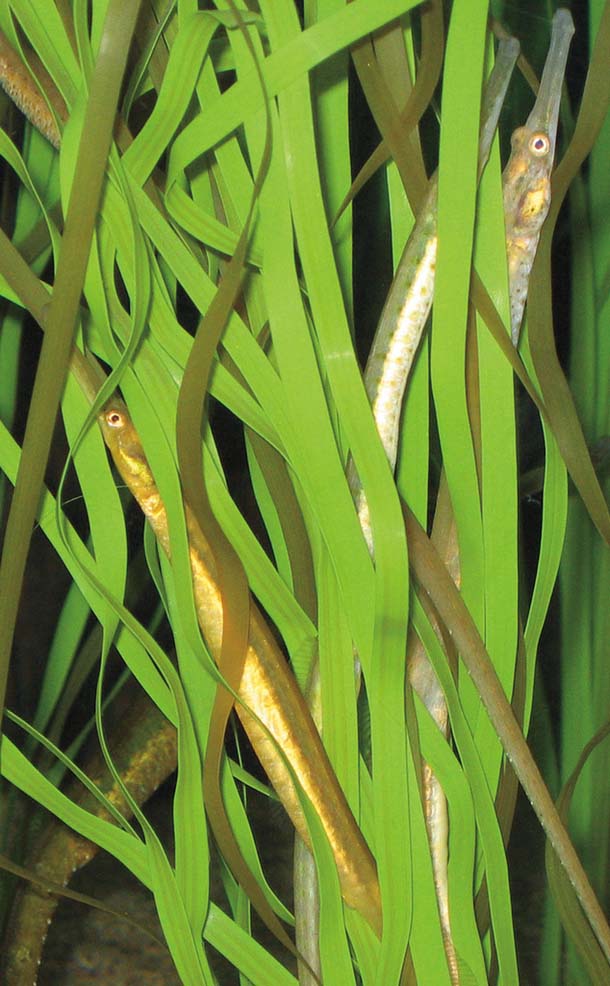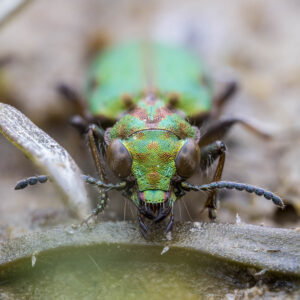In sheltered bays and estuaries, the longer days of spring spur the growth of dense meadows of deep green eelgrass, whose ribbon-like leaves line up with the ebb and flow of the tides like wheat in the wind. If you could see through the water with perfect clarity, you might be surprised to realize that some of those leaves aren’t leaves at all but long, slender fish known as bay pipefish (Syngnathus leptorhynchus), remarkably well-camouflaged seahorse relatives that live in eelgrass beds in bays and estuaries up and down the West Coast.
Like male seahorses, male pipefish brood their young, and each spring marks the start of another breeding season for these skinny, foot-long green fish. Eelgrass beds are perfect nurseries for pipefish and many other species. Mild wave action, abundant nutrients, and protection from predators make them sanctuaries for zooplankton and small fish. The bay pipefish’s long, slender, green body perfectly mimics the swaying eelgrass blades, making it both an elusive prey and a stealthy predator. As the eelgrass flourishes and plankton fills the water in early spring, pipefish reproduction that had tapered off for the winter will begin again in earnest and continue until late fall.
- Pipefish among eelgrass in a tank at Aquarium of the Bay in San Francisco. Photo courtesy Aquarium of the Bay.
The male bay pipefish has a well-developed brood pouch on the underside of its tail. In an elaborate and exact swimming pattern, the female deposits her eggs between the male’s brood pouch flaps. Tissue grows over the flaps, sealing the eggs inside. After releasing sperm and fertilizing the eggs, the male pipefish provides nutrients, oxygen, and water to the developing embryos. The eggs develop into young in about two weeks, with the exact timing dependent on the ambient water temperature. When they’re ready to hatch, the growing pipefish babies split the pouch like a zipper along the ventral seam, emerging as tiny versions of the adult.
Bay pipefish are closely related to kelp pipefish and other Syngnathiformes (fish with “fused jaws”) such as seahorses, pipehorses, sea dragons, and ghost pipefish. In these fish, the “cheek bones” that suspend the jaws have evolved into a tube-like snout with little jaws and lips at the end. This shape is great for sucking up small plankton like rotifers, crustaceans, and fish larvae.
A hunting pipefish is a fascinating physics lesson. To catch its food, a pipefish maneuvers its long body underneath its prey by undulating its dorsal fin. The almost transparent fin oscillates invisibly about 13 to 26 times per second, driving a sine wave on either side of the fin. The waves spill off both sides of the fin in two alternating vortices that collide and create thrust as a tiny jet of water, allowing for slow, precise movement while the fish keeps the rest of its body motionless, and less likely to be detected by its skittish prey.
While the pipefish is positioning itself below its prey, its head locks into position. Muscles along the top of its back start firing, building tension like a compressed spring. Each eye can track prey independently, or the fish can switch to binocular vision, which allows it to better estimate the distance to the prey from below. When the position is just right, it will release the catches holding its skull and snap its head up in a short arc, placing its tiny, vacuum-cleaner mouth right next to its unsuspecting lunch. This all happens at speeds much greater than simple muscle contraction would allow.
The bay pipefish is common in protected bays and estuaries along the Pacific coast from southern Alaska to the mouth of Magdalena Bay in Baja. However, the species has not been studied much at the population level. We do know that eelgrass beds have diminished markedly over the past century, and bay pipefish do not wander far from the eelgrass bed where they were born.
Locally, pipefish are found in San Francisco Bay inland to Suisun Bay, in Drakes Estero, and in Tomales Bay. It can be difficult to spot these elusive fish among the eelgrass from shore or a boat (snorkeling works best!), but in spring watch for grebes catching pipefish to feed their own young.
You can see pipefish at the Aquarium of the Bay (www.aquariumofthebay.com), which is conducting research on pipefish breeding. On April 6, 2009, the Monterey Bay Aquarium will open “The Secret Lives of Seahorses,” an exhibit about pipefish and their relatives (www.mbayaq.org).

.jpg)




